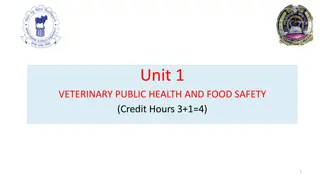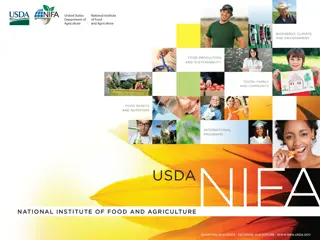
BIS Standards and Consumer Protection in India
Learn about the Bureau of Indian Standards (BIS) and its role in formulating national standards for food and non-food products, promoting quality control, and ensuring consumer protection. Discover how BIS certification impacts the food industry and enhances product credibility.
Download Presentation

Please find below an Image/Link to download the presentation.
The content on the website is provided AS IS for your information and personal use only. It may not be sold, licensed, or shared on other websites without obtaining consent from the author. If you encounter any issues during the download, it is possible that the publisher has removed the file from their server.
You are allowed to download the files provided on this website for personal or commercial use, subject to the condition that they are used lawfully. All files are the property of their respective owners.
The content on the website is provided AS IS for your information and personal use only. It may not be sold, licensed, or shared on other websites without obtaining consent from the author.
E N D
Presentation Transcript
FOOD SAFETY AND FOOD SAFETY AND TOXICOLOGY TOXICOLOGY TOPIC : BIS,AGMARK AND CONSUMER PROTECTION ACT BY D. KINCY ELIZABETH JEYASEELI ASSISTANT PROFESSOR OF FOOD SCIENCE
BIS : AIM : Development of activities , standardization and quality certification. To provide new area for quality control. To ensure the Growth and Development of export products.
PRINCIPLE : It is a national standards body of India which is responsible for formulating National Standards for various types of articles (both edible & non-edible i.e. food & non-food articles e.g. live stock feed, cattle housing, equipments, dairy products, food additives, food hygiene), testing apparatus and methods etc. The old name of this organization was ISI (Indian Standards Institution), which was established in 1947. The new name i.e. BIS came into existence from 1st April, 1987 under the BIS Act 1986 It has 25 members drawn from Central or State Governments, industry, scientific and research institutions, and consumer organisations. Its headquarters are in New Delhi, with regional offices in Kolkata, Chennai, Mumbai, Chandigarh and Delhiand 20 branch offices.
BIS/ISI standards deal with many types of processed food products, apart from non-food products. Similarly. BIS is voluntary and not compulsory; but in 1987, BIS has made it compulsory or mandatory for certain items to have ISI mark. For example, for food colors and additives, vanaspati, containers for packing, milk powder and condensed milk. Therefore, for these two milk products (milk powder and condensed milk), it is now compulsory to have ISI mark.
OBJECTIVES AND FUNCTON OF BIS To formulate Indian standards for various articles, processes, methods of test, codes of practices etc and promote their implementation. To promote the Concepts of standardization and Quality control in industries. To coordinate the efforts of producers and users for making improvements in the materials, products, processes and methods. To operate ISI certification scheme.
To establish testing laboratories of its own. To operate laboratory recognition scheme to meet the requirements of testing. To offer technical and consultancy services within and outside the country.
VISION: To provide efficient timely services. To satisfy consumers. Enhances creditability.
MEMBERS OF BIS: Members of BIS include: Members of Parliament, Ministers of state government, Nominees of central Govt. Ministries and departments, Farmers community, Consumers organizations, Academic institutions, Research institutions, Industry and Professional Associations.
AGMARK AIM : To help farmers get better and remunerative prices by grading of their produce. To frame grade standards of agricultural commodities as per the provisions in Agricultural Produce (Grading and Marking) Act,1937.
PRINCIPLE : The DMI under the Department of Agriculture and Co-operation in the Ministry of Agriculture enforces the Agricultural Products (Grading and Marketing) Act 1937. Under this Act Grade standards are prescribed for agricultural and allied commodities. Agmark grading means grading of an article in accordance with grade/standards prescribed under the provisions of the act. These are known as AGMARK standards.
The grade designation marks shall be applied only to the articles mentioned in the certificate of authorization during the validity period. The certificate of authorization is issued by agricultural marketing advisor or any other officer of the central or state government authorized by the Agricultural Marketing Advisor. The grade designation characteristics vary from product to product. The quality of the product is determined with reference to the size, variety, weight, color, moisture, fat content and other factors are taken in to account.
DEPARTMENTS: Food safety management division system. Quality lab division. Standard division . FOOD PRODUCTS: Dairy products Fats and oils Fruits and vegetables Meat and meat products Fish and fish products.
OBJECTIVES : Giving scientific advice and technical support to the central government. Guidelines for food testing lab. Contributing the development of international standard. Collecting data for emerging risk . Promoting awareness about food safety and nutrition.
FUNCTION : It is product specific certification provided in Agriculture Produce (Grading and Marking) Act. Government of India fixes varied grading standards for different agriculture products which is implemented on state level. To make the products comparable in international market the grading standards are fixed keeping in view the requirements of WTO. The products bearing Agmark must conform to the standard laid down by Directorate of Marketing and Inspection(DMI), any contravention to this may require free replacement of graded products by the producer.
CONSUMER PROTERCTION ACT: AIM : The Consumer Protection Act was passed in 1986 and it came into force from I July, 1987. The main objectives of the Act are to provide better and all round protection to consumers and effective safeguards against different types of exploitation such as defective goods, deficient services and unfair trade practices. It also makes provisions for simple, speedy and inexpensive machinery for redressal of consumer's grievances.
PRINCIPLE : The Act was therefore developed to provide a legislative framework that protects the rights of consumers. As stated in the Act, its main goals are to: Promote a fair, accessible and sustainable marketplace for consumer products and services. Establish national norms and standards relating to consumer protection.
OBJECTIVE : The objectives of the Central Council is to promote and to protect the rights of the consumers such as:- The right to be protected against the marketing of goods and services which are hazardous to life and property. The right to be informed about the quality, quantity, potency, purity, standard and price of goods or services, as the case may be so as to protect the consumer against unfair trade practices; The right to be assured, wherever possible, access to a variety of goods and services at competitive prices ; The right to be heard and to be assured that consumer's interest will receive due consideration at appropriate forums; The right to seek redressal against unfair trade practices or restrictive trade practices or unscrupulous exploitation of consumers; and The right to consumer education. The right to choose.
FUNCTIONS : FUNCTION OF CONSUMER PROTECTION ACT : The Consumer Council Ordinance prescribes the following functions for the Council:- collecting, receiving and disseminating information concerning goods and services and immovable property; receiving and examining complaints and giving advice to consumers of goods and services and purchasers, mortgagors and lessees of immovable property; taking such action as it thinks justified by information in its possession, including tendering advice to the Government or to any public officer; encouraging businesses and professional associations to establish codes of practice to regulate the activities of their members; and undertaking such other functions as the Council may adopt with the prior approval of the Chief Executive in Council.






















